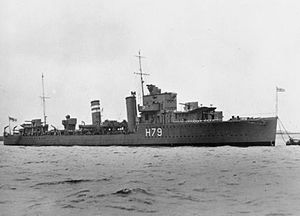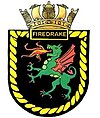HMS Firedrake (H79)

Firedrake at anchor before 1942
|
|
| History | |
|---|---|
|
|
|
| Name: | HMS Firedrake |
| Ordered: | 17 March 1933 |
| Builder: | Parsons Marine Steam Turbine Company, Wallsend |
| Cost: | £243,966 |
| Laid down: | 5 July 1933 |
| Launched: | 28 June 1934 |
| Commissioned: | 30 May 1935 |
| Motto: |
|
| Fate: | Sunk by U-211, 16/17 December 1942 |
| Badge: |  |
| General characteristics | |
| Class and type: | F-class destroyer |
| Displacement: | |
| Length: | 329 ft (100.3 m) o/a |
| Beam: | 33 ft 3 in (10.13 m) |
| Draught: | 12 ft 6 in (3.81 m) (deep) |
| Installed power: |
|
| Propulsion: | 2 × shafts; 2 × Parsons geared steam turbines |
| Speed: | 35.5 knots (65.7 km/h; 40.9 mph) |
| Range: | 6,350 nmi (11,760 km; 7,310 mi) at 15 knots (28 km/h; 17 mph) |
| Complement: | 145 |
| Sensors and processing systems: |
ASDIC |
| Armament: |
|
HMS Firedrake was an F-class destroyer built for the Royal Navy during the early 1930s. Although assigned to the Home Fleet upon completion, the ship was attached to the Mediterranean Fleet in 1935–36 during the Abyssinia Crisis. During the Spanish Civil War of 1936–39, she spent much time in Spanish waters, enforcing the arms blockade imposed by Britain and France on both sides of the conflict.
Several weeks after the start of the Second World War in September 1939, Firedrake helped to sink a German submarine and took part in the Norwegian Campaign in early 1940. She was sent to Gibraltar in mid-1940 and formed part of Force H where she escorted many Malta convoys in the Mediterranean and helped to sink an Italian submarine. Firedrake participated in the Battle of Cape Spartivento and screened the capital ships of Force H as they bombarded Genoa before she was damaged by an Italian bomb in mid-1941. After her repairs were completed the ship became a convoy escort in the Atlantic at the beginning of 1942. Firedrake was torpedoed and sunk by a German U-boat in late 1942 with the loss of most of her crew.
The F-class ships were repeats of the preceding E-class. They displaced 1,405 long tons (1,428 t) at standard load and 1,940 long tons (1,970 t) at deep load. The ships had an overall length of 329 feet (100.3 m), a beam of 33 feet 3 inches (10.1 m) and a draught of 12 feet 6 inches (3.8 m). They were powered by two Parsons geared steam turbines, each driving one propeller shaft, using steam provided by three Admiralty three-drum boilers. The turbines developed a total of 36,000 shaft horsepower (27,000 kW) and gave a maximum speed of 35.5 knots (65.7 km/h; 40.9 mph). Firedrake barely exceeded her designed speed during her sea trials. She carried a maximum of 470 long tons (480 t) of fuel oil that gave her a range of 6,350 nautical miles (11,760 km; 7,310 mi) at 15 knots (28 km/h; 17 mph). The ships' complement was 145 officers and ratings.
...
Wikipedia
